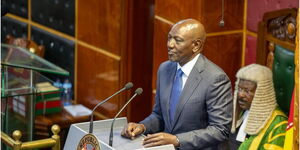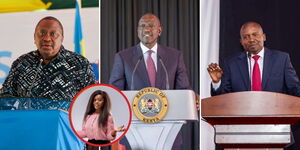Kenya will seek another loan from the International Monetary Fund (IMF), despite assurances by Treasury Cabinet Secretary John Mbadi to cut down on external borrowing.
Central Bank of Kenya Governor Kamau Thugge revealed on Wednesday, August 13, that the country would seek a funded programme ahead of a planned visit by the IMF next month to discuss a new programme.
Speaking during the post-Monetary Policy Committee meeting, Thugge informed that despite the government’s preference to primarily rely on domestic borrowing, more funds would be sought from the IMF to facilitate external debt repayments.
"Our preference will be to have a funded programme, and that is what we have expressed to the IMF board," Governor Kamau Thugge disclosed during the press conference.
In March, Kenya and the IMF abandoned the final review of Kenya's last support programme, and the country did not receive the last batch of its $3.6 billion (Ksh465 billion) Extended Fund Facility and Extended Credit Facility, worth $800 million (Ksh103 billion).
Reasons for the cancellation of the programme were Kenya’s inability to sort out its fiscal deficit and boost revenue collection, two of the main conditions set by the IMF after issuing the loan. This was mostly due to the decision to scrap the proposed increase in taxes in the 2024 Finance Bill because of the nationwide protests.
Many had observed that the country would need a new loan with fresh conditions to meet its external debt repayment targets.
As such, given the struggles in achieving the conditions set out in the previous programme, many had opined that Kenya would opt for a non-funded programme in the new deal.
A funded IMF programme is a financial arrangement where the Fund provides a country with loans to address an economic crisis. Meanwhile, a non-funded IMF programme is a policy-focused agreement where a country commits to specific economic reforms without receiving financial assistance.
In the 2025/2026 Budget, CS Mbadi outlined that the government aimed to borrow a total of Ksh923.2 billion, with Ksh287.7 billion from external sources and a whopping Ksh635.5 billion from the domestic market.
The new IMF programme comes amidst global credit ratings agency Moody’s warning that the cost of servicing debts was expected to remain high. It highlighted weak structures in the nation’s revenue generation and unreliable expenditure structure as key reasons behind the struggles.
Currently, Kenya has a public debt of Ksh11 trillion. Of this, Ksh5 trillion comprises domestic debt, while Ksh5.09 trillion accounts for external debt. Domestic debt largely consists of Treasury Bills and Bonds, whereas external debt is owed to multilateral, bilateral, and commercial creditors.












